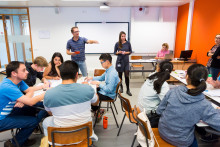The results of the most recent well-being survey depict a similar picture to that of the year before: the UT as an organisation receives a 'grade' of 7.5, according to two sub-measures conducted internally by the UT last year. Some 1,500 employees participated in the survey. Employees are highly engaged: 78 per cent say they feel a lot of energy and 86 per cent feel dedicated to their work.
‘Structurally overburdened’
Those figures are at odds with those related to workload: 38 per cent experience a workload that is (way) too high. This is especially true for academic staff and managers. Overtime is also a persistent phenomenon: 50 per cent of employees work more hours than required - almost a quarter of them more than six extra hours a week. Moreover, it becomes apparent – once again - that employees take vacation days or sick leave to get their work 'done': 27 per cent took vacation days for this last year, compared to 4 per cent who called in sick.
HR policy manager Annemiek Baars confirms the notion that the results do not differ much from last year's well-being survey. ‘The survey results are stable. On the one hand, we can be quite satisfied with a tidy 7.5. We see a stable picture in employee engagement and passion. But on the other hand, there is also a structural overload which is and remains high.’
Realistic workload
Academic staff in particular struggle with this overload; Among other aspects, it mainly stems from the amount of meetings and administrative work. They also report having too little time for research, personal contacts and development. And, as the report states: ‘Only a minority are satisfied with the dialogue held with them regarding a realistic workload.’
‘There are many factors that come into play for certain groups. Certainly academic staff, for example, struggle with performance or publication pressure and the urge to innovate,’ Baars notes. ‘It is important to make those kinds of issues part of the conversation about capacity management. We have developed a tool for this purpose and will soon start a test phase with it. It is a tool with which you can make your tasks and the time they take transparent - and thus open for discussion. Furthermore, in line with our employee well-being action plan, we are focusing, among other things, on leadership expeditions.’
Hybrid working here to stay
The welfare survey also looked at experiences with so-called hybrid working. With the pandemic well behind us, the majority of UT employees seem to have found a mode: 73 per cent work partly at home and partly at UT. And almost 40 per cent of employees prefer to work from home two or three days a week. Therefore, hybrid working seems to be here to stay.
‘We indeed seem to have entered a new normal,’ Baars says. ‘However, we have to keep an eye on certain groups and situations. Between 14 and 25 per cent of teachers, for example, say that online teaching results in lower quality. What is striking: employees mainly want to be able to make agreements on hybrid working within their own teams. But meanwhile, they are wondering what the UT-wide policy is. We want to look at that in the coming period, because it is also linked to housing plans, for example.’
Inclusion en agression
The 2022 well-being survey also included more questions on diversity and inclusion, with a specific focus on social safety and undesirable behaviour. 82 per cent of respondents said they had not experienced any form of undesirable behaviour in the past two years. 14 per cent did experience some form of aggression in the workplace. 4 per cent did not want to answer the question.
‘We do not observe excessive situations - the figures we have are in line with national figures in higher education - but we know there is underreporting,’ Baars notes. ‘In addition, we see that the majority of UT employees - 63 per cent - are positive towards inclusion. That makes us feel positive. But younger employees in particular are a bit more critical about it.’
To address the pains and concerns that surface in the report, Baars states an integrated approach is required. ‘It is on those points that we want to take further actions across the entire HRM chain, from the Human Resource Management research group to the Diversity, Equity & Inclusion Office. In particular, we want to explicitly involve the makers of the report in the consecutive steps. Some problems are easier to solve than others, for instance in the area of workload. A recommendation not to schedule meetings early on Monday mornings is easy to implement. But adjusting the annual cycle - another recommendation, is not that easy to achieve.’






